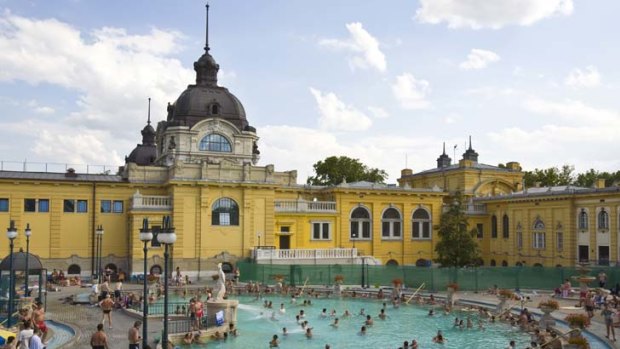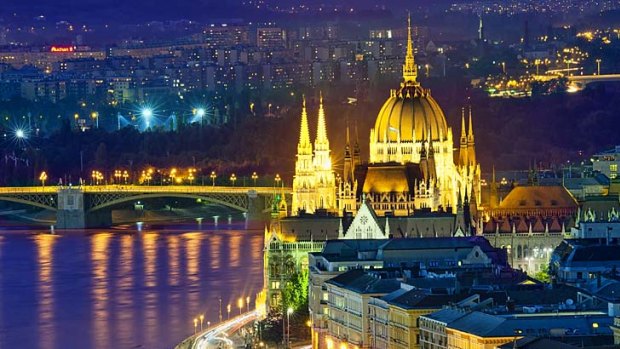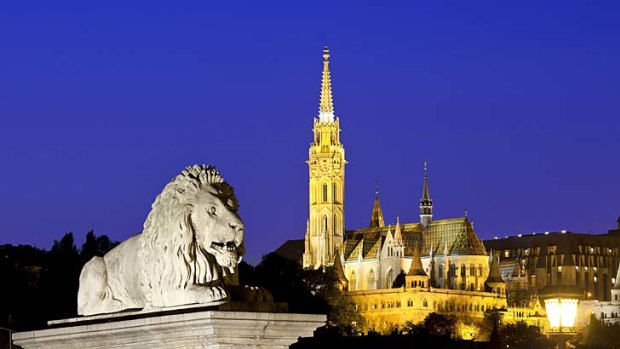This was published 12 years ago
Twenty reasons to visit Budapest
From baths to cruises, churches and wine-tasting, David Whitley's 20 reasons to visit Budapest.

Szechenyi Baths ... one of the largest thermal bathing complexes in Europe.Credit: Getty Images
1 Thermal baths
A good proportion of Hungary is occupied by portly Germans wallowing in thermal waters, and Budapest is riddled with such baths. If you can make it to just one, pick the Szechenyi complex in the large City Park. It's an aquatic wonderland, combining lap pools, spa tubs, whirlpools and waters of different temperatures - and the setting is palatial. There's something of a holiday camp vibe, with sunbathers making a day of it and hairy, middle-aged men standing in the pools, playing chess on the side. spasbudapest.com.
2 The boating lake

Night life ... the Danube River twinkles at dusk.Credit: Getty Images
Also in the City Park is a picturesque boating lake. So far, so run of the mill, but it's what they do with it that counts. During the summer months, the joy of messing around in rowing boats is accompanied by a series of odd sculptures that sit in the water as decorative obstacles. Come winter, the lake turns into a giant public ice rink. artonlake.hu.
3 Danube cruises
Budapest is a major leaping-off point for the European river cruise industry. Visit at any time and you're likely to see long, sleek cruise boats moored along the banks of the Danube. Some are heading up or down the Danube, others connect through to the Rhine. But if the full monty doesn't suit, there are plenty of pleasure cruises that chug up and down the river for an hour. They're best at night, when all the major buildings are lit up and a glass of champagne in your hand seems a logical fit.

Disney-esque ... the Matthias Church.Credit: Getty Images
4 Vasarely Museum
Victor Vasarely was the king of op-art, deliberately producing works that look different depending on where you're standing in relation to them. The museum dedicated to him is in a beautiful old palace in the northern suburb of Obuda but it's worth the trek. It's the art of patterns, concentric lines and perceptual manipulation - it's almost mathematical in approach. More than 400 of Vasarely's works are under the vaulted roofs. Many will seem strangely familiar, reminiscent of psychedelic album covers and TV sci-fi graphics. Best of all, the thought processes and working methods behind the art are explained. vasarely.hu.
5 The Four Seasons Gresham Palace
Budapest has a fair few former palaces that have been converted into hotels but the Gresham Palace is the cream of the crop. It's an art nouveau masterpiece, from the quirky clock hands that indicate which floor the lift is on to the decorative gates. The rooms are all high ceilings, period-style furniture and super-comfortable beds, while the spa and restaurant are highly regarded. But it's the glass roofs in the lobby that get non-guests coming in for a slack-jawed gape. fourseasons.com/budapest.
6 Novelty transport
Cutesy funicular up to the Castle District? Check. Charming cog-wheel railway up Szechenyi-hegy? Check. Ski-style chairlift up to Janos-hegy, the city's highest point? Check. Budapest has an excellent line in fun but largely pointless transport systems. They prove irresistible magnets for kiddy pester-power.
7 The 'Castle'
It's not so much a castle as a fortified complex on a hill but the network of courtyards, walls, gardens and grandstanding buildings doesn't half pull in the crowds. The Budapest History Museum is a rather dry trot through the city's history and the top floor covering the city's early years is the most interesting part. In Roman times, the Danube was the border between the empire and the barbarian hordes. It goes some way to explaining the differences between hilly, sedate Buda on the west bank and lively Pest on the east. The real fun's in the basement, though - the maze of vaulted roofs, chapels and bleakly gothic rooms under the Royal Palace is stark but engrossing. www.btm.hu.
8 Memento Park
When communism crashed in 1989, most of the statues from the Soviet era were pulled down. Some still stand - most notably the beautifully ironic "Statue of Liberty" on top of Gellert Hill - but others have been moved to Memento Park. Effectively a retirement home for ridiculously unsubtle artworks depicting stout workers and wise leaders, this oddity on Budapest's outskirts makes for a surreal stroll-through. The once-pompous symbols of power and victory are now laughable relics.
9 Matthias Church
The Matthias Church, in the Castle District, is a strong contender for the title of Europe's prettiest. Surrounded on the Danube side by the Disney-esque Fisherman's Bastion, the gargoyles on the stone spire make for good close-up shots but it's the colourful mosaic-pattern roof that sticks in the memory. szoborpark.hu.
10 The Hospital in the Rock
In the 1930s a collection of old man-made caves cut into the side of the Castle District's rock was hammered together into a 10-kilometre-long tunnel network. And what did they put inside? Bizarrely, a hospital. With slightly hokey use of waxworks, it has been re-created and tours take you through. Expect horrendous tales of conditions during the World War II Siege of Budapest and fascinating revelations about the underground facility's subsequent use as a nuclear bunker. sziklakorhaz.hu.
11 House of Terror
Designed to tell the tales of the thousands who were persecuted and killed during Nazi and communist rule, this flashy museum set inside the former secret police HQ doesn't always hit the mark. But it's certainly distinctive. The narrative is often relegated to pieces of A4 paper stuck in the corner; each room feels like a separate art installation. You walk into prisoners' cells, past walls made of wax and alongside lift shafts decorated with the photos of victims. It's nothing if not visceral. terrorhaza.hu.
12 Weirdly niche museums
Of course, if these options seem a bit too mainstream, then novelty museum hounds have a tremendous range of options to explore: the Museum of Firefighting, Museum of Hairdressing, Museum of Commerce and Catering and, for those with a sweet tooth, the Marzipan Museum.
13 The Design District
Much more interesting than the chains and global designer labels is the loose association of independents that has turned a chunk of downtown Pest into a rather cool style hub. Loosely bounded by the river, Vamhaz korut, Muzeum korut and Szabadsajto utca, the Design District has transformed once-grungy streets. Offerings swing from vintage fashion to bold textile design via creative perfumeries and specialist chocolates - and they're refreshingly unique. designdistrict.hu.
14 Cheap shopping
Budapest isn't Milan, New York or Paris but it does have enough of the big names to keep the credit card-wielders happy. More to the point, prices tend to be a little lower than in the rest of Europe (and certainly lower than in Australia). So go down Vaci utca for cut-price Zara and H&M, the clunkily branded Fashion Street for bargain Benetton and Hugo Boss and along swanky Andrassy utca for affordable Armani and Zegna.
15 Drinking in kerts
Budapest's kerts - roughly translated as garden bars - carry the spirit of the Design District into the evening. They started as bar complexes built into abandoned courtyards that would pop up for summer, then disappear. Some - such as the excellent Szimpla on kert-packed Kazinczy utca - are now permanent, while existing bars have started adding their own kerts. The look - ramshackle furniture, exposed pipes, uneven surfaces - and vibe - fun, indiscriminate and communal - tend to remain consistent. szimpla.hu.
16 Wine-tasting
For a more sophisticated drinking experience, try getting into Hungarian wines. There are 22 separate regions across the country and drops from all are brought together at the Magyar Borok Haza. Explanatory displays can be found in the sprawling arched cellar, where you can shell out for themed tasting flights. The ones to look out for are the Bikaver - known as "Bull's Blood" - and Tokaji wines. The latter is regarded as Hungary's vino flagship - they're late-harvest dessert wines that come in six degrees of sweetness but are thoroughly drinkable for more than the usual single novelty glass.
17 Goulash soup
Hungary's ubiquitous national dish is a staple at pretty much every restaurant and cafe in town. Just try to leave without eating some ... On the heartier side of the soup-to-stew spectrum, goulash soup usually features beef, paprika and potatoes. The best ones - such as that at Kiado Kocsma on Jokai ter - come with a plate of peppers that you can break up and sprinkle in depending on your levels of fire-breathing bravery.
18 Costes
It took long enough but Hungary finally has its first Michelin star. That comes courtesy of Portuguese chef Miguel Rocha Vieira and his Costes restaurant on the Raday utca foodie strip. It's a sleek, modern-looking affair with a relaxed vibe for a fine-dining joint. Ingredients are sourced from far afield and the eight-course tasting menu with matching wines is the city's top gourmet splash-out. www.costes.hu.
19 Gellert Hill
The city has made noises about building a funicular railway up to Budapest's best lookout but until that eventuates it's a steep, sweaty slog up to the hilltop citadel. Once there, you've got the perfect postcard shot over the Castle District, Parliament Building, Danube and numerous church towers. It's not all about that final photo, though - by and large Gellert Hill is gloriously peaceful woodland, interspersed with pretty bridges, artificial waterfalls and huge statues. You can easily make a morning of it.
20 Margaret Island
If blissful strolling is your thing, then there can be few more idyllic urban spaces in Europe than Margaret Island. Sat in the middle of the Danube, this former private playground of the Habsburg monarchs is traffic-free apart from the giant family-sized bike/carriage contraptions that pootle along the paths. Throw in huge fountains, cute churches and, yes, another thermal baths complex, and it's a near-perfect oasis. hungary.com.
The writer was a guest of the Hungarian National Tourist Office.
Sign up for the Traveller Deals newsletter
Get exclusive travel deals delivered straight to your inbox. Sign up now.